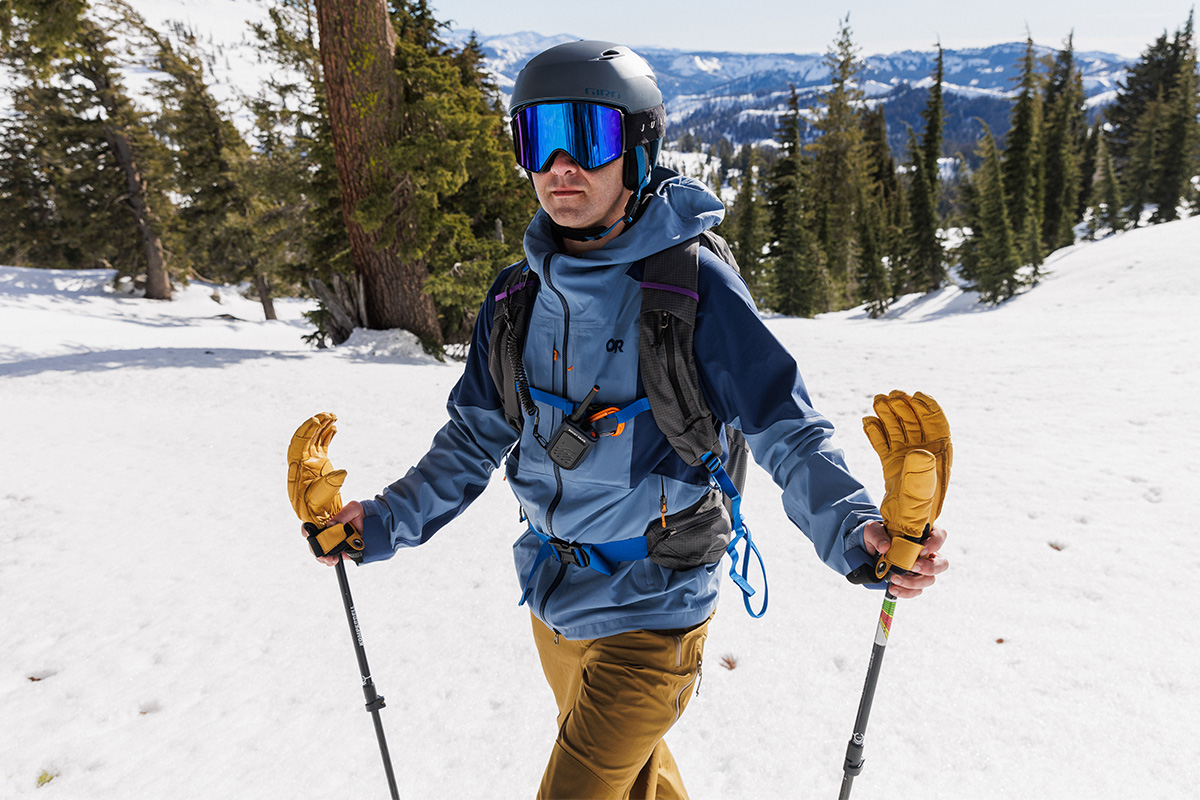
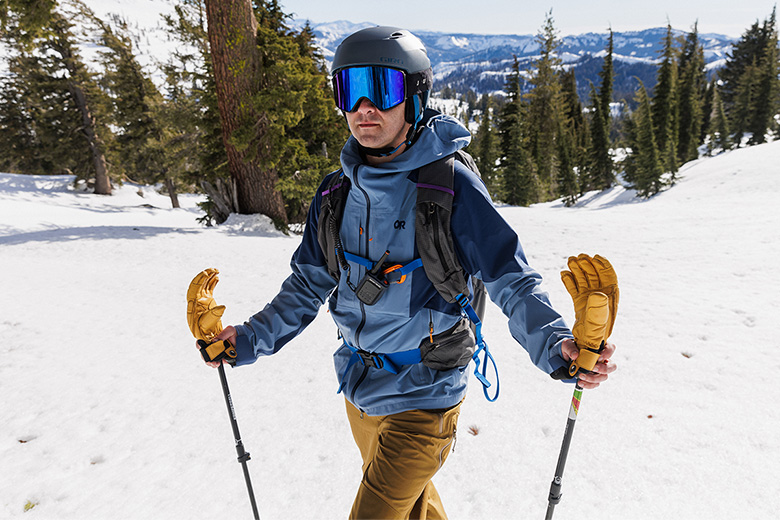
Price: $439
Weight: 1 lb. 4.6 oz. (men’s medium)
Waterproofing: 3L AscentShell
What we like: Softshell-like comfort, breathability, and mobility—great for heart-pumping ski tours in mostly favorable conditions.
What we don’t: Face fabric was quick to wet out in heavy moisture; slightly boxy fit.
See the Men's OR Skytour Jacket See the Women's OR Skytour Jacket
Put simply, Outdoor Research’s Skytour is one of the most breathable hardshell jackets we’ve ever tested. Using OR’s proprietary AscentShell fabric, the jacket fills a niche for backcountry skiers looking to maximize comfort, mobility, and ventilation without totally sacrificing protection in inclement weather. We wouldn’t recommend the Skytour for truly rough and rowdy conditions—the exterior was quick to wet out during a shower test, although the interior remained dry—but for moving quickly in mostly favorable weather, the softshell-like design has a lot of appeal. Below are my thoughts on the Skytour AscentShell Jacket. To see how it stacks up to the competition, check out our articles on the best ski jackets and best men's ski jackets. And to complete your kit, we've also tested and reviewed the men's Skytour AscentShell Bibs.
With a softshell-like construction that prioritizes comfort and breathability, the Outdoor Research Skytour AscentShell Jacket isn’t the most stalwart piece. To be fair, it’s been a great companion for high and dry Sierra tours, but wind and water protection are a noticeable step down from what you get with most Gore-Tex-equipped hardshells. Since conditions in the Lake Tahoe area have been pretty mild this season, I put the Skytour through a shower test to gauge its level of protection in truly wet conditions. Unfortunately, the face fabric wetted out almost instantly, and while no moisture made its way through the exterior, the jacket grew noticeably heavy and damp. It’s likely that prolonged exposure would have led to water eventually seeping through the membrane. Considering Outdoor Research’s roots in the Pacific Northwest, I expected the Skytour to fare better. It’s also worth noting that the jacket’s air permeability translates to subpar wind resistance—if you’re standing on a gusty ridgeline, you’ll likely feel drafts creeping through the shell.
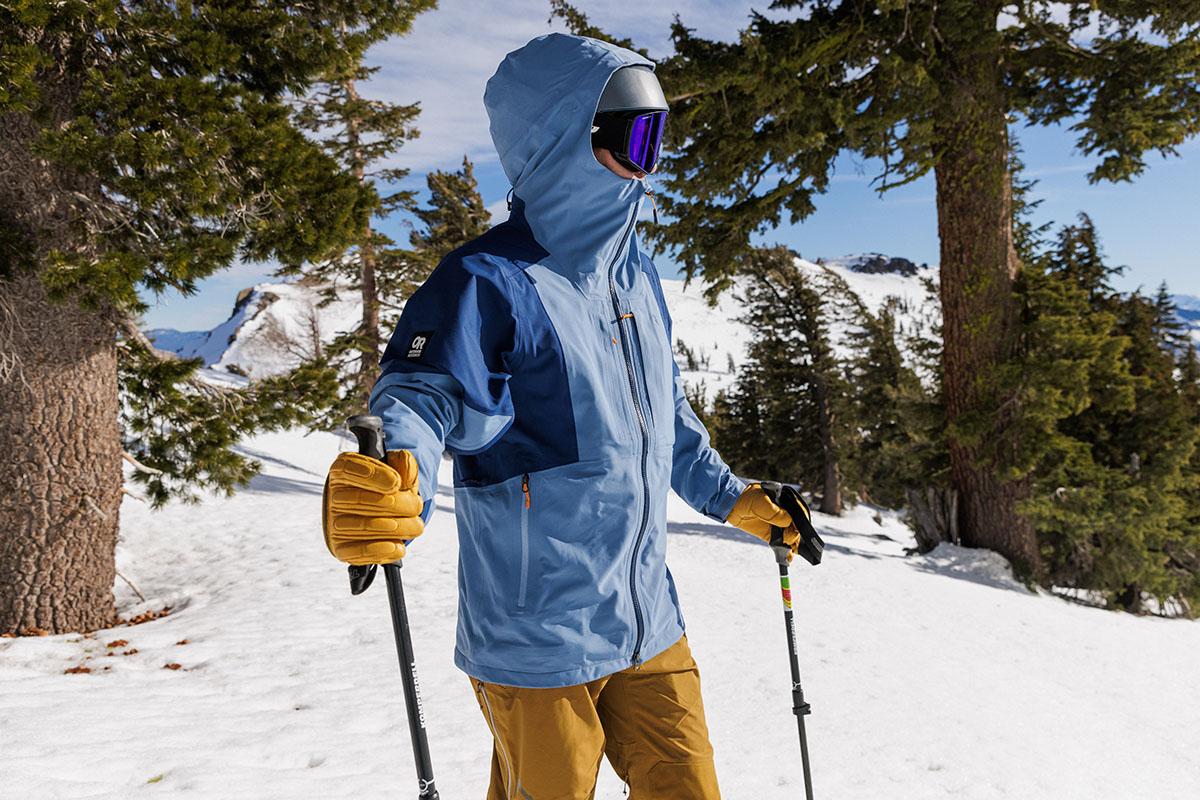
To be fair, the Skytour strikes me as reasonably weather-worthy for areas that get a lot of dry snow (like the Rocky Mountains), as well as mild days when the forecast is mostly favorable. And Outdoor Research did include a number of protective features, including an adjustable and helmet-compatible hood with a brim for deflecting moisture, water-resistant zippers, hook-and-loop cuffs, and a drawcord for cinching the hem. Again, those who frequently ride in truly wet climates like the Pacific Northwest will likely want to look elsewhere, but the Skytour is a nice choice for fast-and-light backcountry missions with minimal moisture in the forecast.
One advantage to the Skytour’s non-impervious feel is that it’s very comfortable. Compared to traditional (i.e., non-stretchy) hardshells, the Skytour feels much more like a softshell jacket with noticeably softer, suppler, and quieter fabrics. The interior features a knit backer that does a good job wicking moisture and feels cozy against bare skin, and the stretchy construction is a boon for long days on the skin track. Another contributor to overall comfort is the jacket’s superb breathability (covered below), which allowed me to keep it on longer than expected. Finally, I appreciate that OR included a brushed tricot chin guard for preventing chafing when the jacket is fully zipped. Added up, it’s a very easy-to-wear piece that goes largely unnoticed throughout the day.
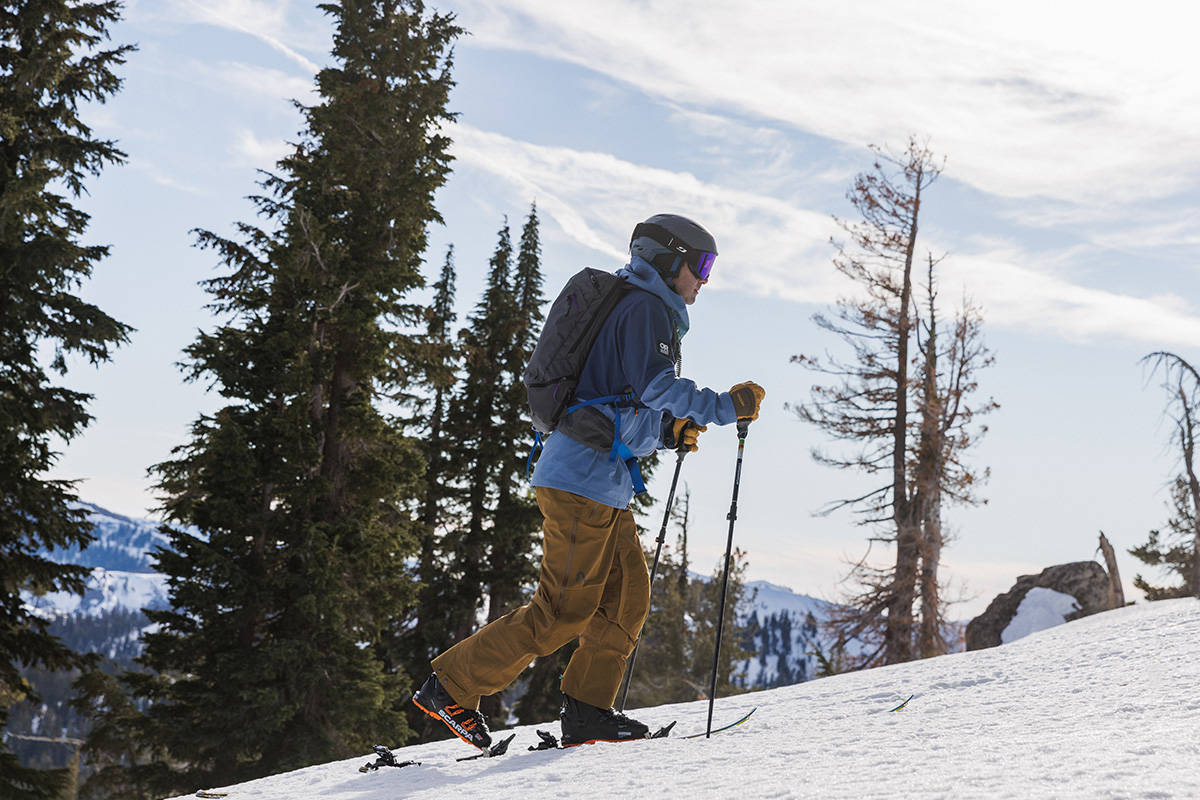
As I touched on above, breathability is a clear hallmark of the OR Skytour AscentShell's design. The stretchy AscentShell fabric is more porous than traditional hardshells, allowing for noticeably better airflow. You also get large pit zips for dumping excess heat, which are easy to manipulate and do a great job regulating temperature. In testing, I found that I was able to leave the Skytour on for extended periods while skinning uphill, which is rarely the case with 3-layer shells. Again, the jacket’s standout breathability comes at the cost of wet-weather protection, but for heart-pumping tours in fair conditions, the Skytour is hard to beat.
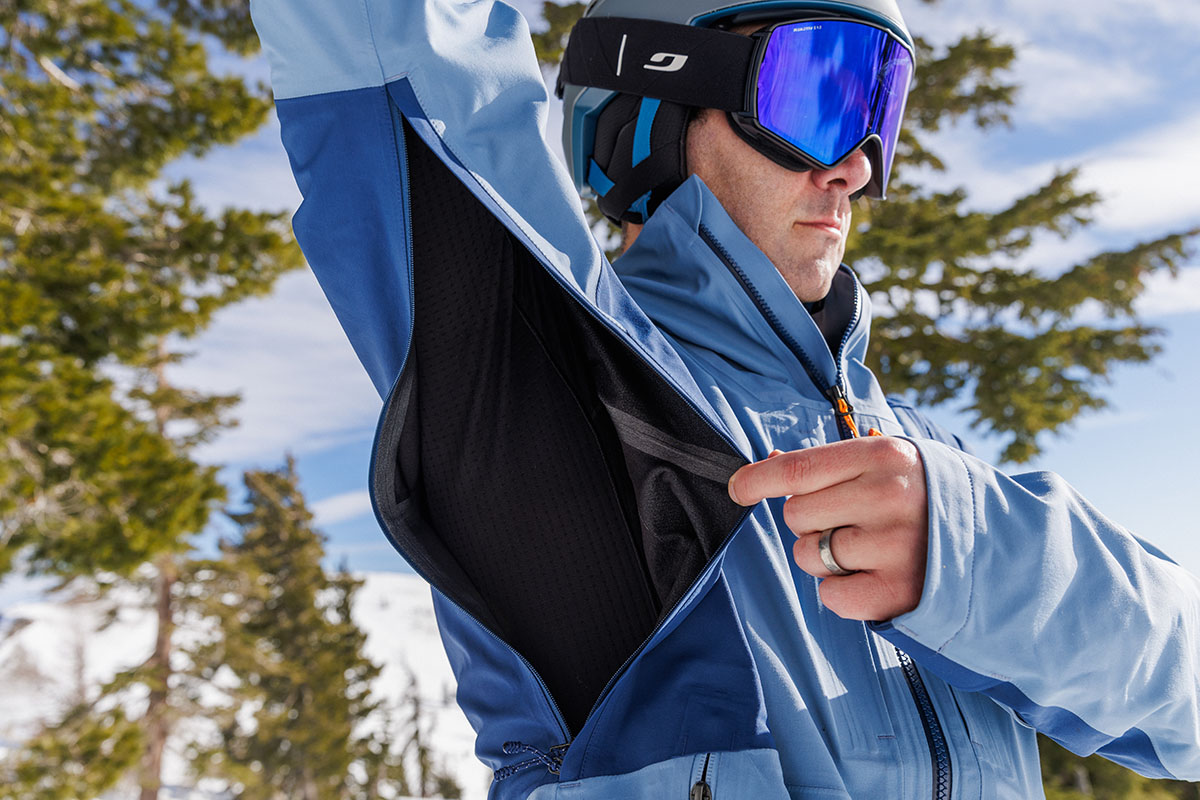
Durability is a bit of a mixed bag with the Outdoor Research Skytour. While not out of place among backcountry-focused pieces, the 40- by 65-denier (D) exterior isn’t the thickest or toughest on the market. As a result, the jacket lacks the robust, bombproof feel of traditional Gore-Tex-equipped shells like Arc’teryx’s Sabre Jacket (80D) or their top-of-the-line Alpha SV (100D). However, the Skytour has held up well thus far in testing apart from the premature wetting out mentioned above, and all of the components (e.g., zippers and drawcords) are well executed and functioning flawlessly after a full season of use. Taken together, I expect the Skytour to have a relatively healthy lifespan—especially if you’re careful when skiing through tight trees and avoid stuffing it into your pack next to sharp equipment like crampons.
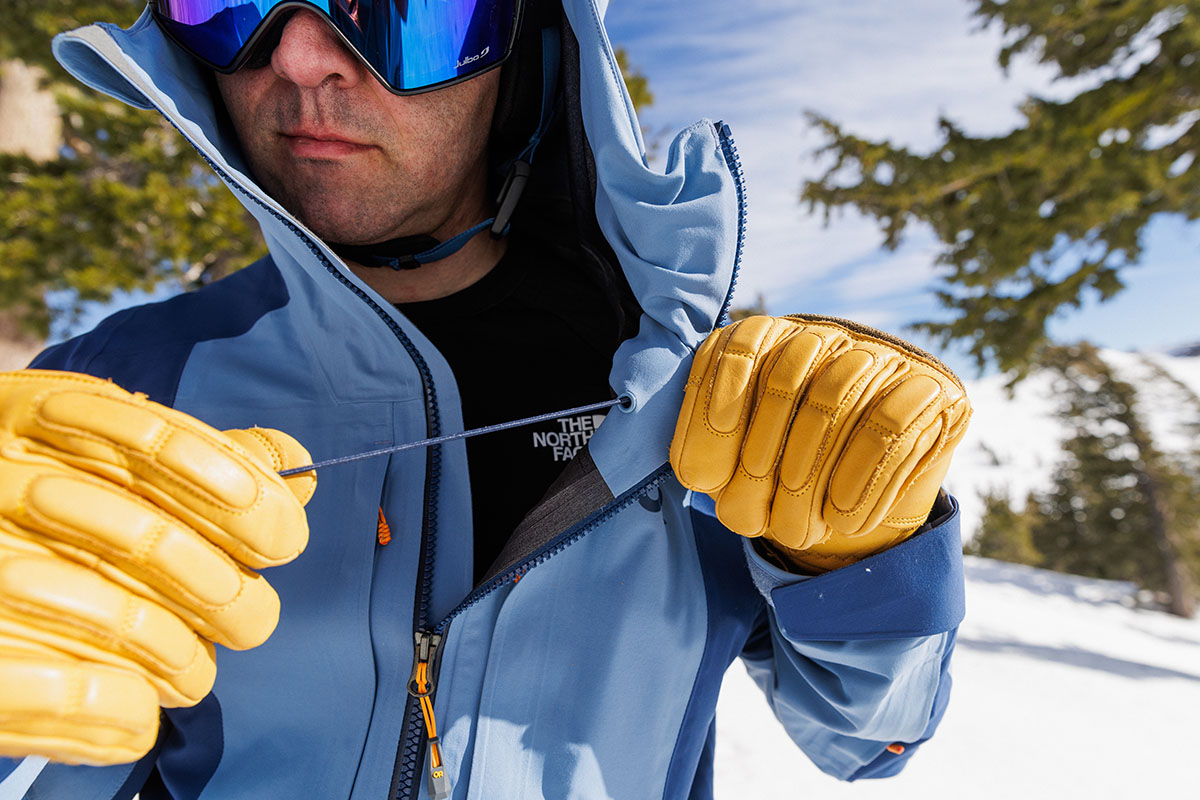
At 1 pound 4.6 ounces on my scale for a men’s medium (it’s listed just a little higher at 1 lb. 5 oz.), the Skytour AscentShell Jacket is about average for a backcountry-focused ski shell. For comparison, Arc’teryx’s venerable Sabre Jacket is heavier at 1 pound 8.9 ounces but features a thicker shell fabric and crosses over better for resort use, while Rab’s similarly stretchy Khroma Kinetic Jacket weighs even less than the Skytour at 1 pound 2.9 ounces but omits hand pockets and uses thinner materials. In other words, the Skytour strikes a desirable middle ground between weight, durability, and features. It packs down pretty well, too—I had no issues fitting it inside a full ski backpack.
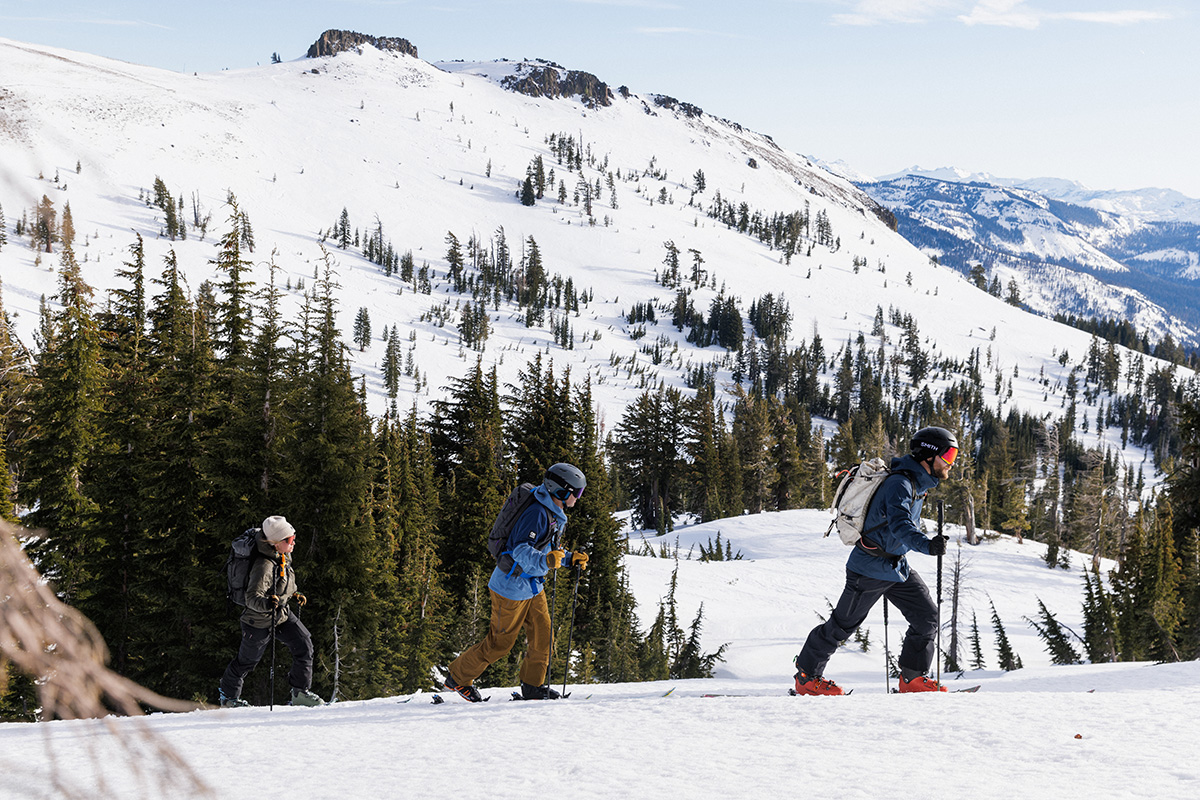
As I mentioned above, the OR Skytour AscentShell Jacket feels pretty complete in terms of features. Starting with storage, you get a total of seven pockets for divvying up the essentials: two hand pockets protected by water-resistant zippers, two chest pockets that are smartphone-friendly, a small zippered pocket on the forearm for a ski pass, an interior chest pocket, and a large internal dump pocket for stashing gloves or a beanie. The forearm pocket is questionable to me given the Skytour’s clear backcountry focus, but it can also be used to stash an ID or car key (there’s a clip inside for security). And I wish the hand pockets were positioned higher to clear a hipbelt or harness, but the flip side is that they’re at a natural height any time you’re not wearing a pack or roped up.
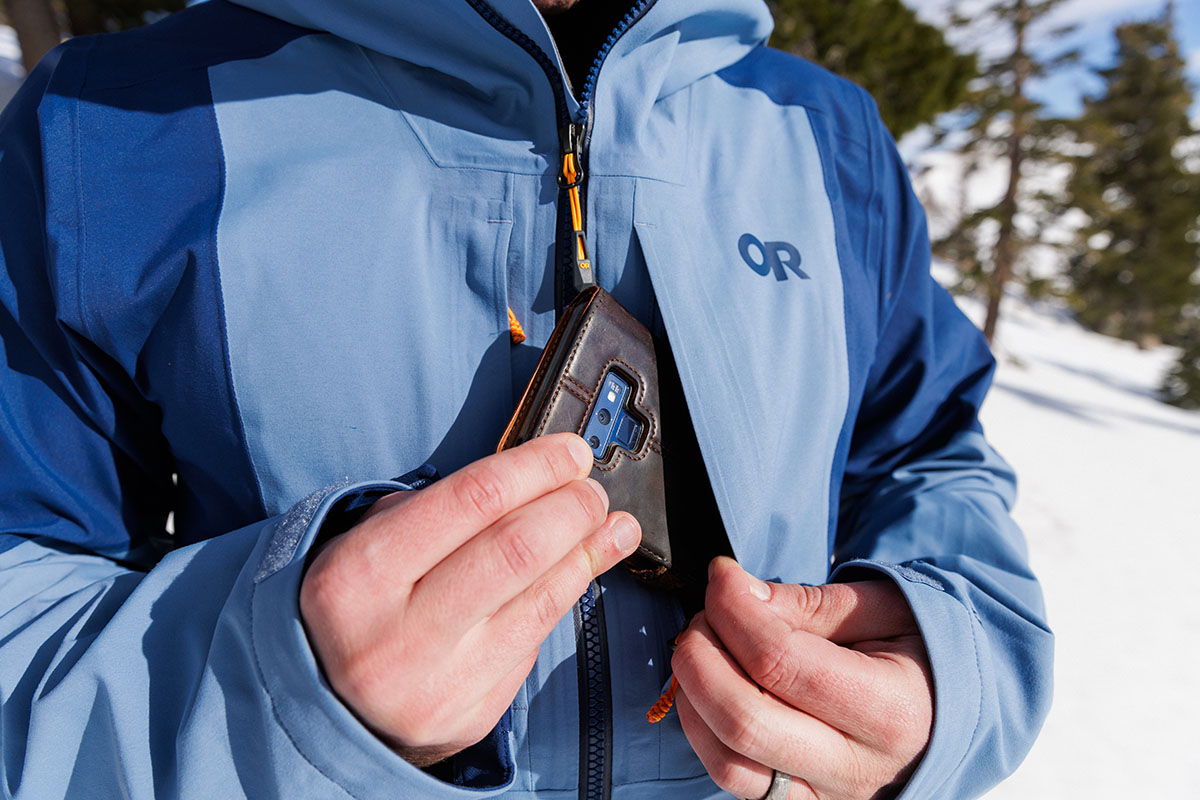
Apart from storage, the Skytour comes equipped with a helmet-compatible hood that’s easy to adjust, even when wearing gloves. When cinched tight, the hood stays securely in place and offers great coverage without impeding vision or restricting movement. The only notable omission is a powder skirt. While this isn’t a dealbreaker to me, I do wish OR had included a tacky silicone strip—similar to what you get with Patagonia’s Untracked and Stormstride jackets—to help keep the Skytour in place when skiing downhill at speed.
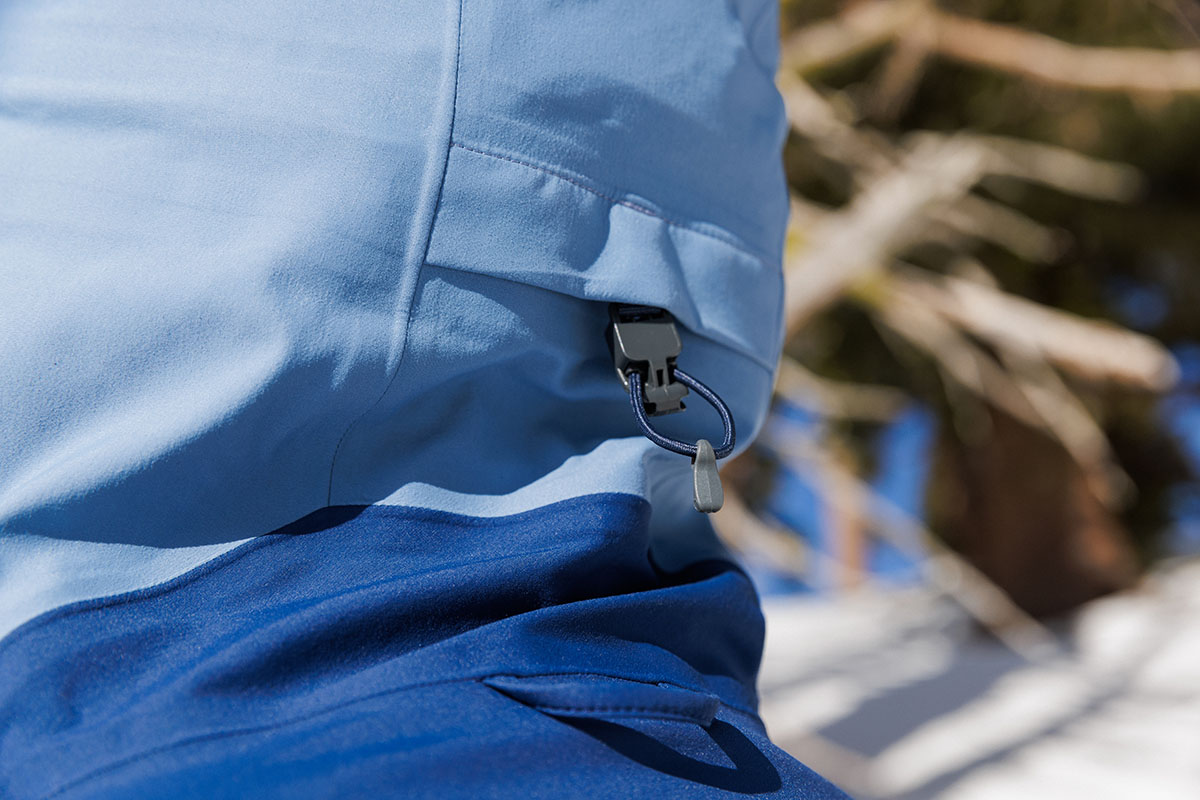
In terms of fit, most modern ski jackets fall into one of two buckets: relaxed, freeride-inspired designs with plenty of room for layering and trim, athletic offerings that have appeal for movement-dependent activities like ski mountaineering. The Skytour lands somewhere in the middle, trending a bit toward the latter end but with a slightly boxy shape. For reference, I was only able to fit a midweight midlayer underneath in my usual size medium, although the sleeve length was spot-on for my slightly above-average wingspan. I also appreciated the fairly generous length for keeping my backside protected on deep days. All in all, it’s not my favorite fit from a styling standpoint, but I never felt restricted or hindered in any way.
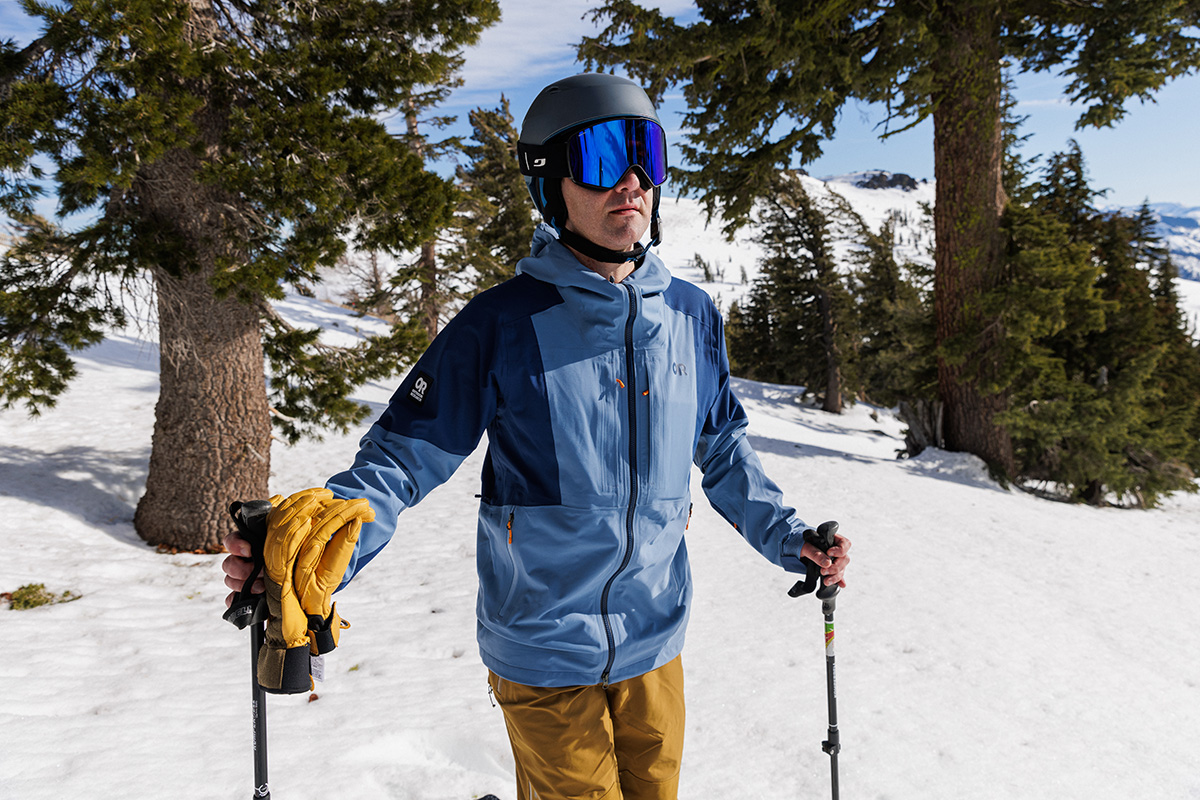
With many states in the U.S. stepping up to ban harmful chemicals found in traditional water-repellent coatings, many outdoor brands have begun transitioning to eco-friendlier alternatives. Outdoor Research opted to do this with their Skytour AscentShell Jacket, utilizing a PFAS-free DWR treatment that forgoes the use of per- and polyfluoroalkyl substances— “forever chemicals” that are notorious for their inability to break down over time. We’d love to see OR incorporate additional sustainability measures like recycled and/or bluesign-approved fabrics in a future update, but we nevertheless appreciate the steps they’ve taken thus far.
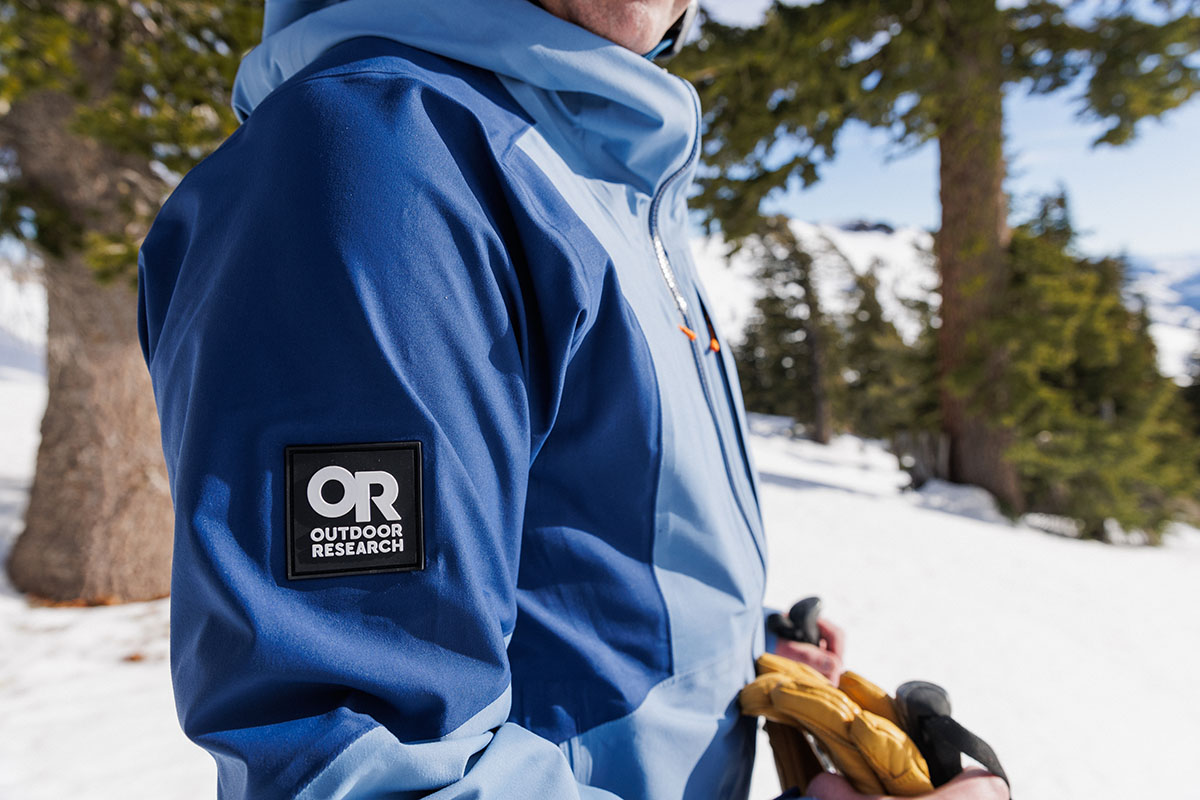
I tested the men’s Skytour Jacket for this review, and OR makes a nearly identical women’s version for the same price. Comparing the two, the women’s Skytour AscentShell Jacket weighs a little less at 1 pound 4.5 ounces and is available in different colorways. Otherwise, the styles are largely similar, including an identical storage layout and overall construction. The collection also includes matching bibs in both men’s and women’s versions, which retail for $429 and boast the same stretchy, softshell-like construction that excels in comfort, mobility, and breathability.
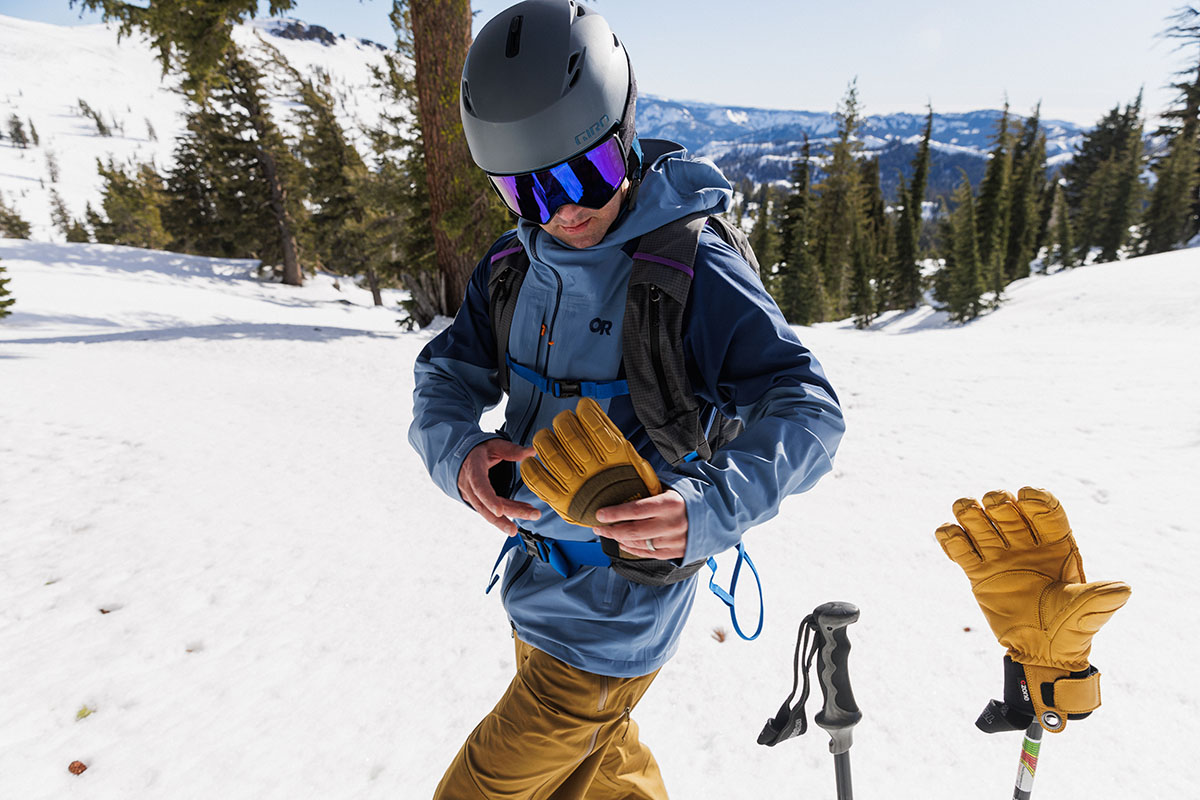
| Jacket | Price | Best For | Waterproof | Weight | Pockets | Denier |
|---|---|---|---|---|---|---|
| Outdoor Research Skytour | $429 | Backcountry | 3L AscentShell | 1 lb. 5.0 oz. | 7 | 40 x 65D |
| Patagonia Stormstride Jacket | $499 | Backcountry | 3L H2No | 1 lb. 4.5 oz. | 4 | 40D |
| Rab Khroma Kinetic | $400 | Backcountry | 3L Proflex | 1 lb. 2.9 oz. | 5 | 20D |
| Flylow Gear Malone | $400 | Backcountry/resort | 3L Tactic | 1 lb. 8.0 oz. | 5 | 100D |
| Arc’teryx Sabre Jacket | $750 | Resort/backcountry | 3L Gore-Tex | 1 lb. 8.9 oz. | 6 | 80D |
The Outdoor Research Skytour AscentShell is our favorite backcountry ski jacket this season, but it’s not without competition. Another one of our favorites is Patagonia’s Stormstride Jacket, which costs a little more than the Skytour at $499 but comes with some advantages. First is protection: While both jackets use in-house waterproofing tech, the Stormstride’s H2No construction has proven to be slightly more weather-worthy than the OR’s AscentShell membrane. The Patagonia also gets the slight edge in weight and comes with a low-profile powder gasket for sealing out snow at the waist, although storage is a little lacking with just four pockets (compared to the Skytour’s seven). Both jackets are very comfortable due to their soft interiors, but the Skytour handily wins out in breathability and will save you a considerable $70. In the end, those who put a premium on protection should spend up for the Stormstride, but the Skytour is our preferred backcountry companion in mostly favorable weather.
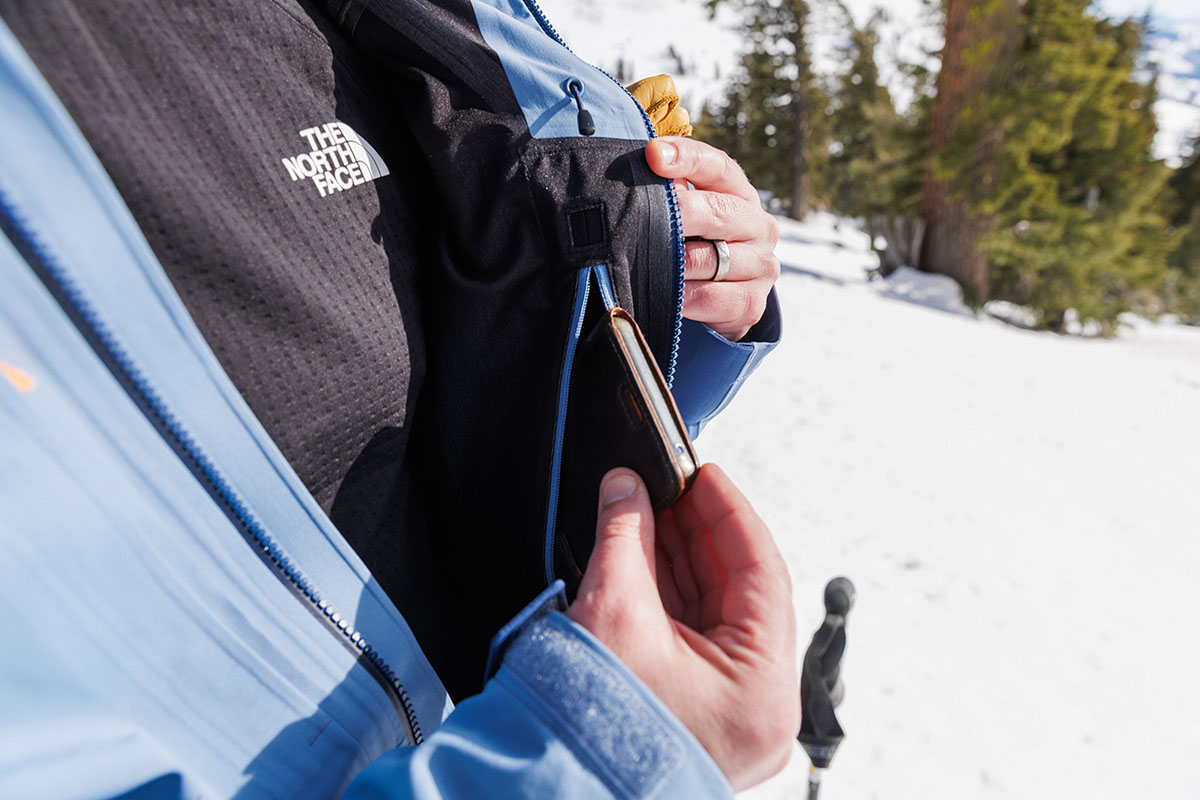
From across the pond, Rab is a technical brand designing high-quality ski shells with competitive price tags to match. Our current favorite is the Khroma Kinetic Jacket, which competes closely with the Skytour as a stretchy and breathable—but still fully waterproof—backcountry design. Highlights include a 3-layer Proflex membrane that's reliably weather-ready, a healthy amount of elastane (10%) for excellent mobility, a competitive weight of just 1 pound 2.9 ounces, and a touring-friendly feature set that includes massive Napolean-style chest pockets, a helmet-compatible hood, and trusty water-resistant zippers. It’s not all positives, however: Most notably, the Rab forgoes traditional pit zips in favor of less effective vents at the back of the sleeves, omits hand pockets, and uses a decidedly thin 20D shell. We still consider it a solid value at $400, but the Skytour is the more complete and versatile backcountry companion.
Next up is Flylow Gear’s Malone Jacket, which, like the Skytour, combines the attributes of softshell and hardshell designs. For sidecountry hikes or quick backcountry tours, the stretchy construction and smooth interior offer standout comfort. If a storm rolls in, the 3-layer waterproof build does a good job blocking wind and snow (although neither design is up to Gore-Tex standards), and the extended collar covers all but your nose when zipped up. We also think Flylow nailed the styling of the Malone—particularly in the tri-color patterns—and all of the materials impressed us from a quality standpoint. All that said, the Flylow is less of a backcountry standout due to its baggier fit and heftier (1 lb. 8 oz.) build. We like it for the 50/50 crowd who splits their time between in- and out-of-bounds use, but for those who exclusively earn their turns, the Skytour is the more purpose-built piece.
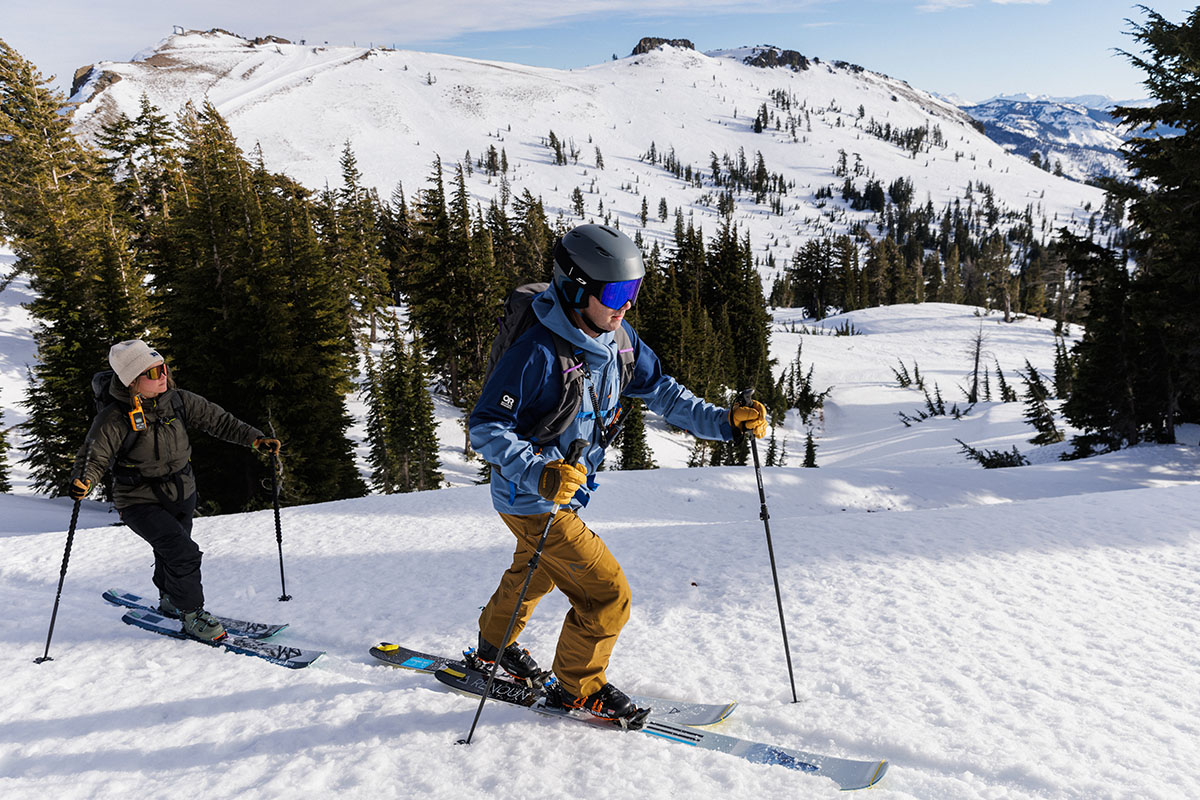
Last but not least is another resort/backcountry crossover option: Arc’teryx’s high-end Sabre Jacket. Right off the bat, we’ll note that the Sabre is a steep investment at $750 and decidedly overkill for the casual rider. But if top-end performance and refinement are what you’re after, the Sabre is hard to beat: It features proven Gore-Tex waterproofing for trustworthy protection even in gnarly weather, a beefy 80D construction that stands up well to frequent use and abuse, and a well-sorted feature set that includes six total pockets and Arc’teryx’s well-loved StormHood. Arc’teryx also tacked on a thin flannel backer for next-to-skin comfort and a light dose of warmth. However, in addition to costing a lot more, the Sabre is heavier than the Skytour at 1 pound 8.9 ounces and doesn’t breathe as well (the biggest trade-off to the more reliable construction). In the end, whether or not the Sabre is worth the investment is up to you, but we consider it one of the most premium and high-performing ski jackets on the market.
If you’re thinking about buying gear that we’ve reviewed on Switchback Travel, you can help support us in the process. Just click on any of the seller links above, and if you make a purchase, we receive a small percentage of the transaction. The cost of the product is the same to you but this helps us continue to test and write about outdoor gear. Thanks and we appreciate your support!
Depending on the seller, most products ship free in the United States on orders of $50 or more. International shipping availability and rates vary by seller. The pricing information on this page is updated hourly but we are not responsible for inaccuracies.